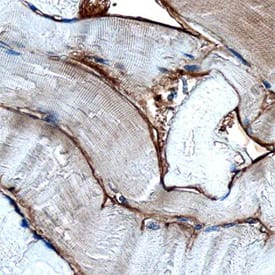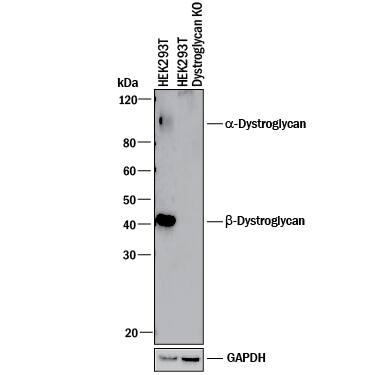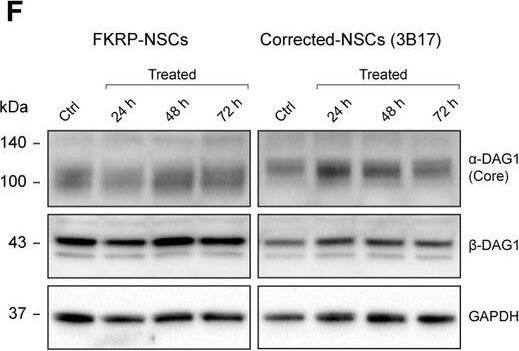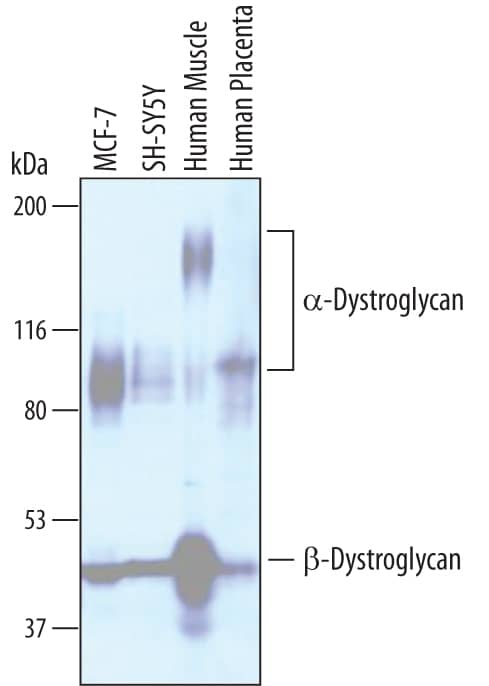Human Dystroglycan Antibody
R&D Systems, part of Bio-Techne | Catalog # AF6868

Key Product Details
Validated by
Species Reactivity
Validated:
Cited:
Applications
Validated:
Cited:
Label
Antibody Source
Product Specifications
Immunogen
Gln28-Val749
Accession # Q14118
Specificity
Clonality
Host
Isotype
Scientific Data Images for Human Dystroglycan Antibody
Detection of Human Dystroglycan by Western Blot.
Western blot shows lysates of MCF-7 human breast cancer cell line, SH-SY5Y human neuroblastoma cell line, human muscle tissue, and human placenta tissue. PVDF membrane was probed with 1 µg/mL of Sheep Anti-Human Dystroglycan Antigen Affinity-purified Polyclonal Antibody (Catalog # AF6868) followed by HRP-conjugated Anti-Sheep IgG Secondary Antibody (Catalog # HAF016). Specific bands were detected for a-Dystroglycan at approximately 100-160 kDa (as indicated) and beta-Dystroglycan at approximately 42-44 kDa (as indicated). This experiment was conducted under reducing conditions and using Immunoblot Buffer Group 1.Dystroglycan in Human Skeletal Muscle.
Dystroglycan was detected in immersion fixed paraffin-embedded sections of human skeletal muscle using Sheep Anti-Human Dystroglycan Antigen Affinity-purified Polyclonal Antibody (Catalog # AF6868) at 3 µg/mL overnight at 4 °C. Before incubation with the primary antibody, tissue was subjected to heat-induced epitope retrieval using Antigen Retrieval Reagent-Basic (Catalog # CTS013). Tissue was stained using the Anti-Sheep HRP-DAB Cell & Tissue Staining Kit (brown; Catalog # CTS019) and counterstained with hematoxylin (blue). Specific staining was localized to basement membrane. View our protocol for Chromogenic IHC Staining of Paraffin-embedded Tissue Sections.Western Blot Shows Human Dystroglycan Specificity by Using Knockout Cell Line.
Western blot shows lysates of HEK293T human embryonic kidney parental cell line and Dystroglycan knockout HEK293T cell line (KO). PVDF membrane was probed with 1 µg/mL of Sheep Anti-Human Dystroglycan Antigen Affinity-purified Polyclonal Antibody (Catalog # AF6868) followed by HRP-conjugated Anti-Sheep IgG Secondary Antibody (Catalog # HAF016). Specific bands were detected for a--Dystroglycan at approximately 110 kDa -and beta-Dystroglycan at approximately 42 kDa (as indicated) in the parental HEK293T cell line, but is not detectable in knockout HEK293T cell line. GAPDH (Catalog # AF5718) is shown as a loading control. This experiment was conducted under reducing conditions and using Immunoblot Buffer Group 1.Applications for Human Dystroglycan Antibody
Immunohistochemistry
Sample: Immersion fixed paraffin-embedded sections of human skeletal muscle
Knockout Validated
Western Blot
Sample: MCF‑7 human breast cancer cell line, SH‑SY5Y human neuroblastoma cell line, human muscle tissue, and human placenta tissue
Formulation, Preparation, and Storage
Purification
Reconstitution
Formulation
Shipping
Stability & Storage
- 12 months from date of receipt, -20 to -70 °C as supplied.
- 1 month, 2 to 8 °C under sterile conditions after reconstitution.
- 6 months, -20 to -70 °C under sterile conditions after reconstitution.
Background: Dystroglycan
Dystroglycan, also DAG-1 (Dystrophin-associated glycoprotein 1) is a 180-200 kDa heterodimeric adhesion molecule that links the cell cytoskeleton to the extracellular matrix. It is found on skeletal muscle, cardiac muscle, fibroblasts, smooth muscle and keratinocytes. DAG-1 binds multiple matrix molecules, including laminin-1 and -2, agrin, and perlecan. Intracellularly, the cytoplasmic tail of DAG-1 contributes to a large 400 kDa complex that interacts with the cytoskeleton. The human DAG-1 preprocursor is a type I transmembrane protein 895 amino acids (aa) in length. It contains a 27 aa signal sequence plus an 868 aa proform that undergoes autocatalysis to generate a 626 aa alpha-chain (aa 28-653), and a 242 aa beta-chain. Mature DAG-1 is a heterodimer composed of noncovalently linked alpha‑ and beta‑chains. The alpha-chain possesses one potential Ig-like domain (aa 64-162), a mucin-like region (aa 316-485), and a peptidase S72 domain (aa 500-733). It is O‑glycosylated and runs from 100-160 kDa in SDS-PAGE. The beta-chain is N-glycosylated and runs at 42-44 kDa in SDS-Page. It possesses a short 95 aa extracellular region (aa 654-749) plus a 120 aa cytoplasmic domain (aa 776-895). Membrane cleavage of the beta-chain causes dissociation of the heterodimer and generates a 30 kDa truncated form. Over aa 28-749, human DAG-1 shares 93% aa identity with mouse DAG-1.
Long Name
Alternate Names
Gene Symbol
UniProt
Additional Dystroglycan Products
Product Documents for Human Dystroglycan Antibody
Product Specific Notices for Human Dystroglycan Antibody
For research use only



